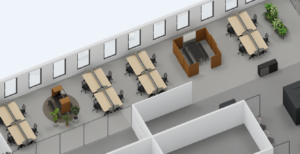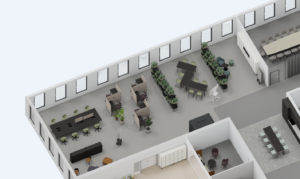Well-functioning New Work offices consist not of a (random) collection of creative room shapes and an Instagram-ready lobby, but of structured office layouts, which create an optimised work environment.
The new significance of the office space.
The current trend towards more home-based work and remote work, fuelled by digitisation and AI, is changing the importance of the company office significantly. According to the L&R Social Research institute in Vienna, around 25% of employees now work remotely from home for at least part of the time. In the USA, this quota is already significantly higher at approximately one third. In the future, it will therefore increasingly be a matter of how employers manage to avoid the imminent loss of corporate identity and fill the resulting void in the offices.
Creating work options.
Due to space efficiency and saving requirements, the increasing numbers of employees working from home will naturally lead to space consolidation in company offices. Shared spaces are growing in number, permanently assigned workstations are increasingly being called into question and replaced or supplemented with flexible work options that provide the best place to work for each job. Unfortunately, in practice, this often results in a wild mix of different room shapes, without regard for corporate culture, productivity, acoustics and ergonomic requirements. It’s all about being trendy.
Giving structure to the office..
If you want to give more prominence to creative and collaborative areas in your office building – and you definitely should because these will be the main concerns of future offices – then you need a clear spatial structure. This calls for planning concepts and office layouts with sensibly demarcated zones: quieter areas (home base) for focused working, team meetings and video conferences; and public zones (HUB areas) for inter-departmental collaboration, creative project work and social exchange.

Open Unit in the Homebase vs. Market + Creative Space in the Hub-Area
A spatial mix of the quieter home base with generally more lively HUB areas should be avoided at all costs because otherwise disturbance is unavoidable. Giving structure means decentralising these two overarching zones in the plans within the constraints of the building.
In the home base, short distances ensure fast access to the relevant infrastructure, such as the technology island, coffee kitchen or sanitary facilities. Even in the open team offices, or open units, it should be possible to work without being disrupted – with few frills and little distraction. Acoustically shielded retreats are available for confidential conversations. In contrast, the public HUB areas allow a lot of organisational and creative freedom, with the aim of promoting collaboration and creative exchange. Inter-departmental room types, such as coworking landscapes, creative spaces and corporate campus, create new working and communication opportunities. They are the breeding ground for boosting corporate identity and innovation. The home base areas will tend to shrink in the future because the increase in the proportion of employees working from home will lead to space consolidation in the direct working environment. In contrast, the HUB areas will become more important and will be expanded.
Attractive New Work offices bolster innovation and employee retention.
The tension between working at the office and working from home can be reconciled much better by planning company offices so as to make them more attractive and needs-oriented. Structuring office landscapes properly not only boosts company innovation, but it is also an important lever against the shortage of skilled workers. Strengthening employee retention and thus reducing recruitment pressure appears to be an effective counter-strategy. Smartly designed offices that meet the demands of flexible and agile working contribute enormously to this.



